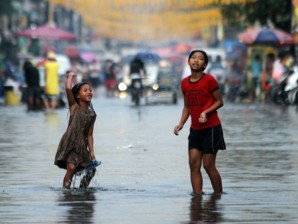Pagasa unveils color coding for rain alerts
Is it going to rain today? The weather bureau will deliver the answer to this age-old question in yellow, green or red.
The Philippine Atmospheric, Geophysical and Astronomical Services Administration (Pagasa) on Tuesday unveiled a color-coded rainfall alert system and a thunderstorm warning system for Metro Manila, a first for the country.
The new warning system should help communities and local governments prepare for landslides, flash floods and river spills that could necessitate evacuation, Pagasa said.
Under the heavy rainfall warning system, a yellow warning is raised when the expected rainfall amount is between 7.5 mm to 15 mm within one hour and likely to continue.
Communities given this advisory are advised to be aware of the weather condition and warned that flooding may be possible in low-lying areas.
The green alert is raised in areas where rainfall is between 15 mm to 30 mm within one hour. Flooding is a definite threat in communities under the green alert.
A red alert is issued when downpours constitute an emergency, Pagasa said. This is raised when observed rainfall is more than 30 mm within one hour or if rainfall has continued for the past three hours and is more than 65 mm.
When Pagasa raises this warning, communities should be prepared to respond. It means serious flooding is seen and that residents should be ready to evacuate to safety.
Thunderstorms alert
The alert system for thunderstorms, which produces isolated rain showers for short durations, specifies the likelihood of the formation of this weather condition over a certain area.
It will be raised when thunderstorm formation is likely within the next 12 hours and when it threatens a specific area within the next two hours.
All these alert systems will be disseminated through SMS, Twitter, the Pagasa website and faxed advisories.
In the case of tropical storms, Pagasa will issue two warnings that would give a better picture of the weather conditions over certain areas.
One will constitute the public storm warning signals, which is based on the cyclone’s wind strength, and the other will be for rainfall amount.
“The rains from a cyclone are not symmetric. Some areas will have more rains than others,” said Pagasa Administrator Nathaniel Servando.
